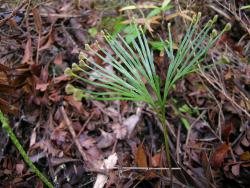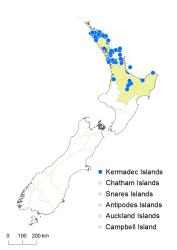- ≡ Acrostichum dichotomum L., Sp. Pl. 1068 (1753)
- ≡ Osmunda dichotoma (L.) Spreng., J. Bot. (Schrader) 1799(2): 268 (1800)
- ≡ Ripidium dichotomum (L.) Bernh., J. Bot. (Schrader) 1800(2): 127, t. 2, fig. 3 (1801)
- = Schizaea forsteri Spreng., Anleit. Kenntn. Gew. 3, 157 (1804)
- ≡ Schizaea dichotoma var. forsteri (Spreng.) Domin, Biblioth. Bot. 20 (85): 207 (1915)
Rhizomes short-creeping; bearing glossy, chestnut-brown, septate hairs, 1.5–3.5 mm long. Fronds 60–460 mm long, 20–140 mm wide, fan-shaped. Sterile portion of frond dichotomously divided 3–7 times, erect, 55–450 mm long, flattened, margins entire, 1.0–1.5 mm wide, brown proximally, shiny green distally, occasionally red when young, bearing scattered hairs. Fertile portions of frond pinnately divided, 2–8 mm long, 1–6 mm wide; fertile branches infolded, in 4–8 pairs, 2–7 mm long, undivided or sometimes dichotomously branched, with fimbriate margins. Sporangia borne in one row either side of midrib of fertile branches, 10–15 per branch; long hairs present amongst sporangia.
Schizaea dichotoma is easily recognised by its fan-shaped fronds with shiny green, flattened, dichotomously branched sterile laminal segments. The short fertile segments are confined to the tips of the sterile segments.
North Island: Northland, Auckland, Volcanic Plateau, Gisborne.
Kermadec Islands.
Altitudinal range: 0–500 m.
Schizaea dichotoma occurs on the Kermadec Islands and from Kaitaia, through Northland and Auckland, to Kāwhia, extending to East Cape and south to Rotorua and Lake Taupō. It grows from near sea level on some offshore islands to c. 500 m on Little Barrier Island, the Paeroa Range, and Rainbow Mountain, near Rotorua.
Also widespread in the tropics and subtropics; East Africa, Madagascar, Mascarene Islands, southern India, Sri Lanka, south-east Asia, Australia (northern Western Australia, Northern Territory, Queensland, NSW) and throughout the Pacific from New Caledonia to the Marquesas Islands.
A terrestrial fern usually found under lowland kauri forest; also under mānuka scrub, around thermal sites in the Rotorua/Taupō area, or occasionally under pōhutukawa, tawa or pūriri forest and on sandstone banks.
The species was given a conservation status of Naturally Uncommon by de Lange et al. (2013).
n = 77 (Lovis in Holttum 1959); n = c.540 (Brownlie 1961). The latter count may have been an erroneous count from a tapetal cell.





